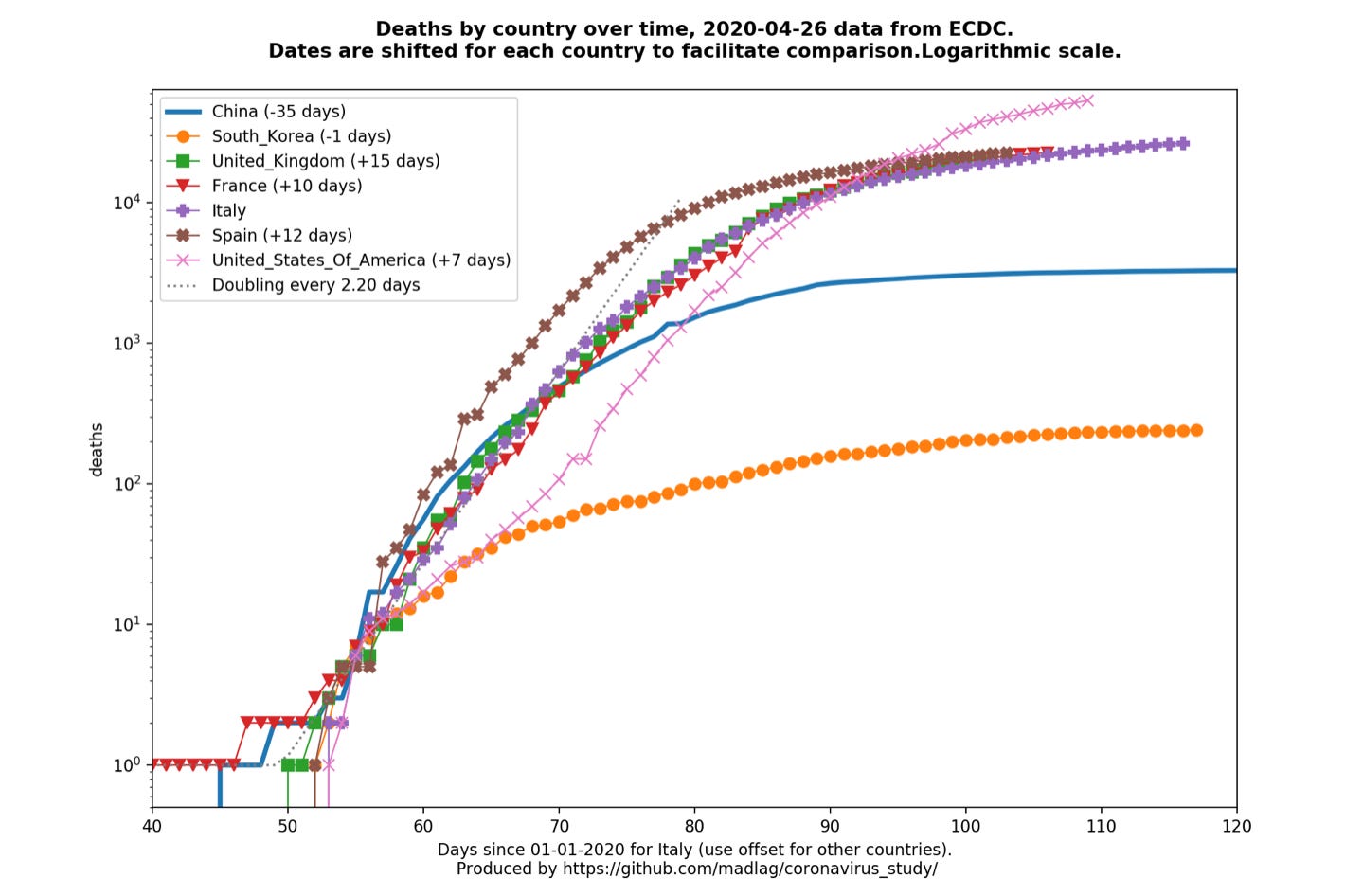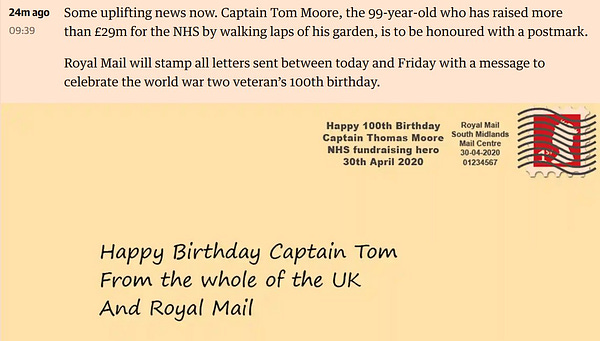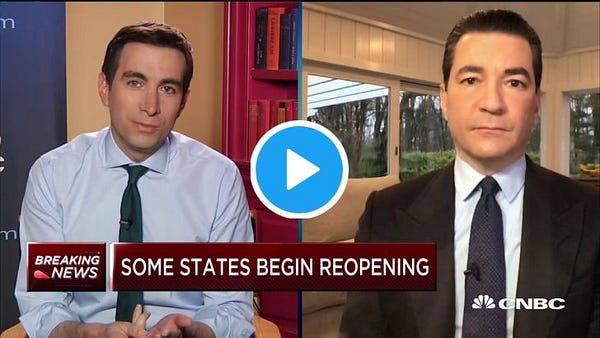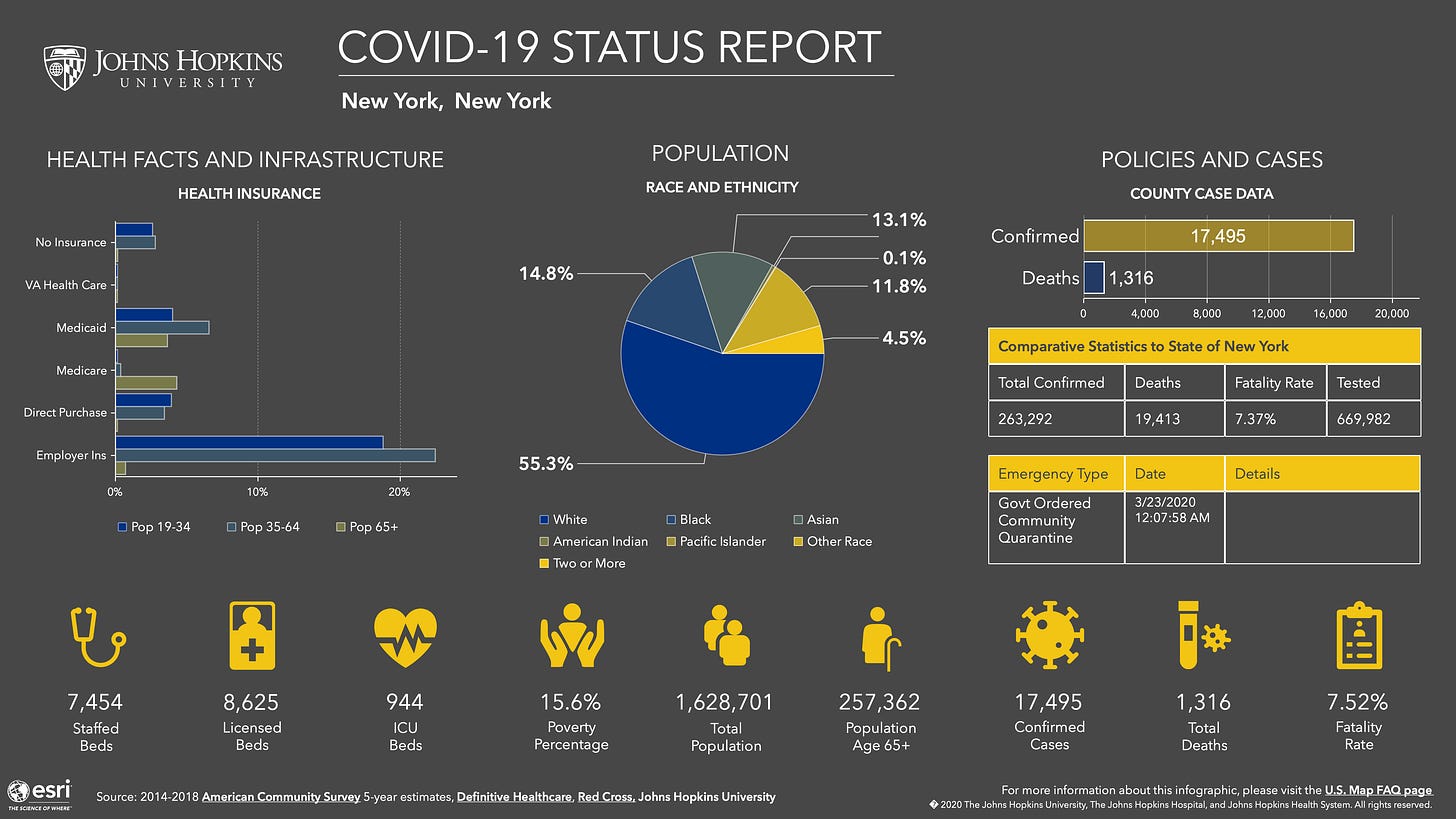🦠 COVID-19 | Failing the Marshmallow test
I am a scientist by education, banker at JPMorgan for a few years, then mature PhD student in Chemical Biology at Oxford under the supervision of Christofer Schofield (FRS) and Peter Ratcliffe (Nobel laureate in medicine in 2019). Founder and tech investor focusing on media and education. I care about science, learning and Democracy which are good bedfellows.
📊 Daily Data Brief:
3,003,889 (+91,843) cumulative cases
Active cases: 1,914,109 (+37,701) (this is the number of currently infected patients)
Total Deaths: 207,103 (+4,167)
Serious/Critical Cases: 57,635 (-543)
Recovered: 882,677 (+29,975)
Source: Worldometers
Death curves (updated daily as ECDC releases). Major update with per country graphs now available (Link) (US, UK, France, Germany, Sweden) (👈NEW❗️)

The Stanford marshmallow experiment (also known as the Marshmallow test) was a study on delayed gratification in 1972 led by psychologist Walter Mischel. In this experiment, a child is given a marshmallow and is left alone with the marshmallow for 15 minutes. The child is told that if he does not eat the marshmallow while the experimenter is away he will get another marshmallow or a pretzel whatever is his preference. The research shows that the children who did not eat the marshmallow have better outcome in life.
It is a good analogy of where most countries stand with regards to re-opening. This analogy was made by Kai Kupferschmidt in relation to Germany as some of its Länder reopen:

Kupferschmidt’s article together is included with one from STAT news which reports on a US study that most states do not have the adequate level of testing for re-opening. It might be that citizens will be the adults in the room and exercise caution as Scott Gottlieb believes in today’s Video of the day. Gottlieb is also leading a $46.5 billion package bi-partisan proposal to Congress detailed today. On the vaccine front an Oxford group seems to be quietly ahead of the pack, while a secret US group is allegedly pushing for a Manhattan project for COVID19.
The Corona Daily also pulls an article from 2003 during SARS, on how the WHO dealt with China secrecy at the time and wonders why Dr Tedros did not take the same line with COVID19. There is a great article on the relationship between experts, government and the public.
Another podcast with Bill Gates (including a shorter summary).
It looks as if the adult who govern us are tempting us to fail our marshmallow test. We should aim resist and act for a better future.
Article of the day: Sharon Begley writes “Many states are far short of Covid-19 testing levels needed for safe reopening, new analysis shows” for STAT news. (Link)
Begley reports on a study by Ashish Jha (director of the Harvard Global Health Institute) et al. showing that most states do not have the required testing capacity to re-open safely. The article includes some great state-by-state visualisation.
“But the new state-by-state review reveals a far more fragmented picture: 31 states and the District of Columbia were doing too little testing last week to identify most infected people in a timely manner. Ten states would need to increase their daily testing totals by at least 10,000 to do so by May 1. New York, for instance, would have to perform more than 100,000 more tests a day, and New Jersey 68,000 more. Nineteen states — all but two in the South or the western half of the country — are already doing enough testing.”
Let us hope that residents of these states use more caution than their governors. Begley’s article is not as lofty and spectacular as the article “The Secret Group of Scientists and Billionaires Pushing a Manhattan Project for Covid-19” published in the Wall Street Journal, but it could be equally if not more important in successfully containing the pandemic.
Captain Tom: On “moral elevation”, the feeling we get when witnessing the exceptional moral beauty of Captain Tom Moore’s act.


Video of the day: Former FDA director, Scott Gottlieb, on consumer confidence will not be brought back because states re-open. It will be brought back when “there isn’t pervasive spread of #coronavirus across the entire nation”.


🇩🇪 Kai Kupferschmidt writes “Reopening puts Germany’s much-praised coronavirus response at risk” for Science. Germany has been an example in a numbers of ways from having “Christian Drosten at Charité University Hospital in Berlin develop the world’s first diagnostic test for SARS-CoV-2 in mid-January, which was quickly shared worldwide”, to Angela Merkel having been a great role model on how you communicate on a pandemic to your citizens.
An unpublished study for the small town Gangelt in western Germany claiming that 15% of its inhabitants had been infected and that based on this percentage you could derive that the fatality rate of COVID19 was 0.37% was recently published. And it seems that even though it was not peer-reviewed, it allowed politics to take over, and gave the leaders of the Länder (equivalent to US States) the desired green light to start to reopen.
Kupferschmidt, as well as Merkel, believe that Germany’s Länder might be squandering their exemplary containment of the first peak. Let us hope it will not be the case, and as Scott Gottlieb pointed in the video above that the citizens will be less reckless than their leaders. (Link)
🇺🇸 Franco Ordones writes “Ex-Officials Call For $46 Billion For Tracing, Isolating In Next Coronavirus Package” for NPR. Ordones reports on a detailed plan put forward to Congress by a bi-partisan group of ex-officials including Scott Gottlieb and Andy Slavitt. The $46.5mm funding is aimed at 3 areas:
$12 billion to help expand the contact tracing workforce. The officials estimate the workforce needs to increase by 180,000 until a vaccine is on the market.
$4.5 billion to use vacant hotels so that infected and exposed people without a place to self-isolate have somewhere they can go so they don't spread the virus.
$30 billion to offer 18 months of income support — a per-person stipend of $50 a day, like jury duty — for those voluntarily self-isolating.
Great to see a bi-partisan and sensible effort, as in a pandemic public health should trump politics. (Link)
💉 David D. Kirkpatrick writes “In Race for a Coronavirus Vaccine, an Oxford Group Leaps Ahead” for the New York Times. Some will see mostly negativity in the use of the word ‘race’ in the article title, but you can be first and generous. Adrian Hill’s group at the Jenner Institute seems to have a head start:
“That has enabled them to leap ahead and schedule tests of their new coronavirus vaccine involving more than 6,000 people by the end of next month, hoping to show not only that it is safe, but also that it works.”
They also have shown efficacy of the virus in 6 rhesus macaques inoculated with their vaccines and appear to be several months ahead of other groups, apart from a Chinese group reported in yesterday’s Corona Daily using similar technique to theirs.
The Oxford group believe it could have the first few million doses by September. It is running an accelerated trial timetable:
“The institute last week began a Phase I clinical trial involving 1,100 people. Crucially, next month it will begin a combined Phase II and Phase III trial involving another 5,000. Unlike any other vaccine project now underway, that trial is designed to prove effectiveness as well as safety.”
Paradoxically, the Oxford Group is better placed that the Chinese group, being located in the UK where the epidemic has yet to be controlled contrary to China. It is ethically admissible to infect healthy people with a candidate vaccine in an area where COVID19 is spreading, whereas China could struggle if it applies the same ethical rules. If the UK contains its epidemic, Adrian Hill group will have to recruit candidates for his trial in the next foyer of the epidemic. Let us hope that this is the first vaccine that Adrian Hill and his group discover. (Link)
🇨🇳 Brahma Chellaney (Professor of Strategic Studies at the New Delhi-based Center for Policy Research and Fellow at the Robert Bosch Academy in Berlin) writes “The Chinese Health Organization?” in Project Syndicate. It is a damning piece about the World Health Organisation as you can tell from the title. But the more interesting part is a New York Times article (“China Discovers Secrecy Is Expensive”) from April 2003 during SARS. In it the author writes the following about China:
“And the central government did not share any information with outside doctors until almost six weeks after that, by which time SARS had taken Hong Kong by surprise.
This reticence -- or obstruction -- has prompted the biggest backlash since the Tiananmen Square crackdown nearly 14 years ago. China was rebuked by the World Health Organization for its handling of SARS, a black eye from a United Nations agency that rarely confronts member states.”
And one has to ask: why didn’t Dr Tedros (current head fo the World Health Organisation) rebuke China for its obfuscation around COVID19, the same way his predecessor had done during SARS? (Link)
🏛 Jana Bacevic writes “Science in inaction – The shifting priorities of the UK government’s response to COVID-19 highlights the need for publicly accountable expert advice.” on the London Schools of Economics blog site. This is detailed and thorough article on whether the government did “follow the science” as it claims when formulating its policy for COVID19.
It looks how various narrow groups of expertise (referred by Bacevic as ‘epistemic positions’) fight for privileged access to policy makers, and how it can lead to problematic (or even catastrophic) policy outcomes particularly when dealing with complex problems like a pandemic. Bacevic powerfully argues that:
“What we need instead is a relationship between different kinds of ‘science’, policy, and society that is open, non-hierarchical, and aware of the inevitable limitations of any single epistemic position. This also requires trust in the capacity of the ‘public’ to learn about and evaluate different kinds of specialist knowledge.”
It is urgent that we improve this relationship. It goes beyond the transparency which has recently been advocated and which is just the starting point. (Link)
🎬🇺🇸 “Bill Gates’s vision for life beyond the coronavirus”: an interview by Ezra Klein of Bill Gates for Vox. There is also a text summary of the 53 min 09 sec interview included. (Link)
One of my friends have inferred from Scott Gottlieb’s Op-Ed in the Wall Street Journal “America Needs to Win the Coronavirus Vaccine Race” (in yesterday’s Corona Daily), that we were at the start of “Vaccine imperialism”. Bill Gates downplays this scenario in the interview:
“I think in the end the US will show up in a strong way, even though it certainly hasn’t to date. The US Congress has been the most generous on HIV funding for the entire world. It’s been one of the most generous to GAVI in terms of funding vaccines. The US government has helped the health of the entire world. It’s been a huge part of the reduction in death.
In this case, not only is it humanitarian, it’s about strategic relationships and it’s about making sure the disease isn’t coming back into the US as we participate in global commerce that we benefit immensely from. So I think what you’re seeing in the short term, in terms of how the US is engaging, isn’t where we’ll end up. There are many voices that are going to push us to work with Europe and work with other countries and be part of the innovations that will bring this to an end.”
📊 A picture is worth a thousand words: Global (🌎) and local (with relevant flag) visualisation and forecasting tool
🌎The Financial Times (NEW❗️visualisation) has a data tracking page which is in front of the paywall, looking at cases and fatality curves for selective countries and metropolitan areas/region. It is not as extensive as the Madlag link below, where you can see static as well as animated images for a greater number of individual countries. (Link)🇺🇸 The John Hopkins University resource center was the first one I used back in January they have now made available in their latest iteration a county by county dashboard in the US including information about health capacity, insurance coverage, ethnicity and age breakdown of the population (New York example below) (Link)

💊 The "Map of Hope" provides a geographical overview of planned, ongoing and completed clinical trials. It is put together with data from WHO Clinical Trials Search Portal by the Heidelberg Institute for Geoinformation technology. (Link)
🌍 MRC Centre for Global Infectious Disease Analysis started to publish weekly death estimates for countries (Link)
🇺🇸 The US Center for Disease Control and Surveillance (CDC) publishes “A Weekly Surveillance Summary of U.S. COVID-19 Activity” (Link)
Google has published a new website to “See how your community is moving around differently due to COVID-19”. They have a lot of data to do so… (Link)
🇺🇸Another valuable resource by Unacast ( a data company providing human mobility insights). Their “Social distancing scoreboard looks and compares (State by State and County by County), the change in mobility to prior to COVID19 (Link)
🌎 Country by Country Curves: This is a GitHub made by my friend Francois Lagunas. He has written a script to scrape deaths and number of cases in order to visualise the rate of growth on a logarithmic scale. Great resource (Link)
CityMapper has started to produce City Mobility Index to show how much a City is moving. This is a very good indicator of how well lockdowns are respected around the world: Barcelona (4% of city moving) at one end and St Petersburg at the other end (68% of city moving) for yesterday (Link)
🌎A great resource put together by Ben Kuhn and Yuri Vishnevsky. At a time when we need solidarity and cooperation, I prefer their subtitle “We need stronger measures, much faster” than their title. It’s a simulator on what case growth looks like depending on your community’s measures. Fantastic resource to stir communities and governments to action (Link)
🇩🇪 The COVID19 dashboard for Germany is one of the best around. (Link)
🌎A helpful guide by VOX of the “9 coronavirus pandemic charts everyone should see” (Link)
🌎Data and chart regularly updated by the Centre for the Mathematical Modelling of Infectious Diseases at the London School of Hygiene & Tropical Medicine. It maps the effective reproduction number (also known as R0) of COVID19. You want to get it below 1 as fast as possible to contain an epidemic. (Link to see charts and more data about your country)
🌎This is a great COVID19 Dashboard prepared by Andrzej Leszkiewicz. Andrzej has also written an introductory and explanatory blog for it (“Coronavirus disease (COVID-19) fatality rate: WHO and media vs logic and mathematics”). I particularly like the country comparison tab, which allows you to track and benchmark the curve of the epidemic (number of cases and deaths) in your country with that of another. Very well done and informative. (Link)
“Going Critical” by Kevin Simler is a detailed interacting essay talking about complex systems, the importance of understanding networks, modelling and how this applies to: memes, infectious diseases, herd immunity, wildfire, neutrons and culture. Must read (Link)
🏛 Notable tracking projects
💊“COVID-19 treatment and vaccine tracker”. This tracker contains an aggregation of publicly-available information from validated sourcesby the Milken Institute (Link)🏛Tariq Krim has started a COVID19 website tracking data about each government policy response to the pandemic (Link)
🏛Oxford COVID-19 Government Response Tracker (OxCGRT) was launched yesterday. Data is collected from public sources by a team of dozens of Oxford University students and staff from every part of the world. It also looks at stringency of the measures and plots stringency with case curves. A great initiative and resource (Link)
👩💻Mike Butcher (Editor at Large Techcrunch and founder of TechforUK), had refocused TechforUK on the fight against COVID19. It is a very effective hands-on team of volunteer. Do reach out to them. He has also teamed up with We are now working closely with the volunteers behind the “Coronavirus Tech Handbook”. (They are ‘cousins’ of ours who originally created the Electiontechhandbook). Volunteer collaboration at its best! (Link)
📰 Cronycle resource:
Cronycle has made available a number of open-access feeds on its website which I extensively use for the Corona Daily. The four first feeds are:
1. COVID-19 General (Link)
2. COVID-19 x Resilience (Link)
3. COVID-19 x HCQ/CQ (Link) (HydroxyChloroquine and Chloroquine)
4. Gig Economy x COVID-19 (Link) 5. Supply Chain x COVID-19 (Link)
5. Supply Chain x COVID-19 (Link)
Human Rights x COVID-19 (Link)



